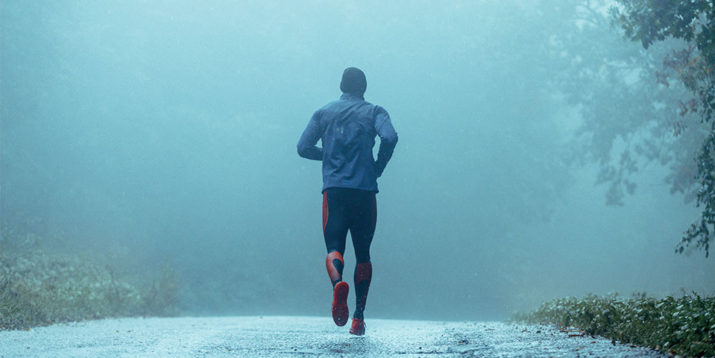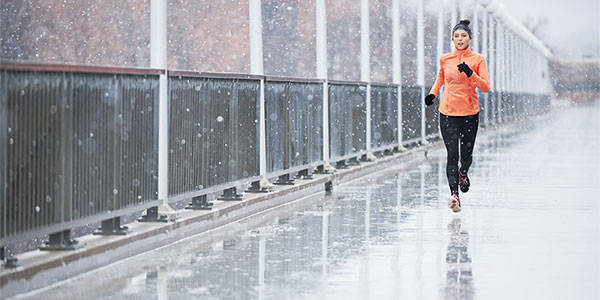Everything You Need to Know to Go Running in the Rain

Running in the rain is not unlike running in general: demanding and occasionally uncomfortable, but also super gratifying — and maybe, JUST MAYBE, even a little fun. Of course, it requires more caution and preparation than pounding dry pavement, but that shouldn’t deter you from scoring a great workout.
Instead of resorting to the treadmill next time it pours, embrace the elements. All you need is the right gear and attitude. Keep reading for expert tips on running in the rain.
How Should I Dress for Running in the Rain?
The first thing you’ll want to figure out is what to wear for a rainy run. It ain’t rocket science, but there are a few helpful rules to follow.
1. Pick the right tech
The first point of order is choosing technical, moisture-wicking running clothing, says Meghan Kennihan, NASM-CPT, run coach for USA Triathlon and Road Runners Club of America. Look for material made from synthetic fibers like nylon and polyester, or natural fibers like merino wool. These are sweat-wicking fabrics, which means they don’t hold onto moisture and therefore won’t weigh you down. They also won’t hold moisture against your skin, so you won’t be as cold as if you wore, say, cotton.
2. Dress for temps
The next factor that should guide your rain-running gear is air temperature.
If it’s warm or humid…
Rain can cool you down and provide relief from the heat. “There’s an unavoidable physiological penalty when you run in the heat,” says Janet Hamilton, exercise physiologist, running coach, and owner of Running Strong. “But when you get that wonderful rain shower, it’s blissful.”
When that’s the case, wearing minimal, fitted clothing is wise, says Carl Leivers, a USA Track and Field-certified run coach. “That way you don’t soak up a lot of water, you’re not dealing with a lot of heavy or baggy clothes, and keeping it tight-fitting can help reduce the risk of blisters,” he explains. A brimmed hat or visor will help shield your eyes from the rain, he adds.
If it’s cold out…
Colder temperatures naturally demand more gear. In addition to the basics — moisture-wicking base layers and a brimmed hat — Leivers recommends wearing a breathable, lightweight shell jacket to keep yourself dry in the rain. Avoid cotton or fleece outerwear, Kennihan adds, since “these items will not only get heavy, but also keep you chilled because they’ll stay wet.”
What about a rain jacket?
Waterproof rain jackets and pants are also a no-go, Kennihan says. The material traps body warmth and moisture, creating sauna-like conditions that can cause discomfort at best and overheating at worst.
3. Save money: skip the waterproof running shoes
Don’t fall for this highly flawed technology. Not only can water seep in around your ankle, the material isn’t breathable. “I’d be worried about the problem of sweat from my feet not being able to evaporate or escape,” Hamilton says, “leading to increased risk of blisters.”
For a rainy run, she recommends sticking to your usual pair of shoes, unless you’re running technical single-track trails. In that case, Hamilton says, specialty trail-running shoes will offer more traction on muddy paths.
4 Tips For Running in the Rain

1. Lube up
Basic chafing and blister prevention can save you from tons of pain, especially on a long run in the rain. To minimize chafing, swipe Vaseline or Body Glide onto sensitive areas like your inner thighs, underarms, feet, and chest or nipples. For blister prevention, Hamilton suggests wearing a pair of thin socks outside of your regular running socks.
2. Stick to the roads
When you’re running in the rain, it’s best to avoid slippery surfaces like grass and trails — unless you have proper footwear and plenty of trail-running experience, Hamilton says. That means running on paved surfaces.
Keep in mind, though, that drivers may not be able to see you well in the rain, Kennihan says. To stay safe, she suggests running on sidewalks whenever possible, and wearing light reflective or fluorescent clothing so you’re always visible.
3. Don’t attempt a personal record
“To some extent,” says Leivers, “I think you need to temper expectations.” Understand that running in the rain might detract from your performance, but you can still focus on giving your best effort, he explains. “If you get too wrapped up [thinking], ‘Oh man, this feels so hard and it’s still slow!’ then you’re setting yourself up to let the elements win,” he says.
4. Run till dry
If you’re lacing up for a cold, wet run, make sure your route ends right at your car or, ideally, your front doorstep, Hamilton says. Running in the rain doesn’t necessarily put you at risk for sickness, but hanging around in drenched, cold clothes afterward can. After your run, get dried off and warm as quickly as possible, Hamilton says.
Should You Run in the Rain?
Running in the rain may be challenging, but it’s totally doable. What’s more, it strengthens your resolve as a runner. “If you go out and train in less than ideal conditions,” Hamilton says, “you build up your confidence and mental toughness.” Leivers agrees: “Being able to push yourself is never a bad skill to practice,” he says.
